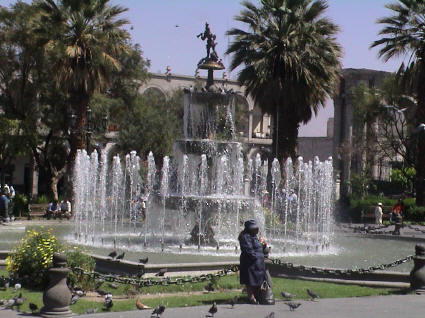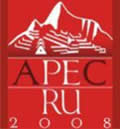United Kingdom
| Welcome |
| Peru in Brief |
| History |
| Geography |
| Government & Politics |
| Maritime delimitation between Peru and Chile |
| News |
Links |
| AREQUIPA | |||
 |
|||
| Main Square | |||
| Capital: | Arequipa | ||
| Elevation: |
2,378 m | ||
| Climate: |
Temperatures vary between 10°C and 24°C. January February and March have moderate rainfall, otherwise the weather is mostly sunny. |
||
| History: |
Cave art from 7600 B.C. and stone implements from at least 5000 B.C. have been found in the region. Tradition has it that, on arriving with the royal family, the Inca ruler Mayta Capac ordered, "Arequepay" (you shall settle here – whence Arequipa . Crops are still grown on many of the terrace- the Incas had built for this purpose. |
||
| The first Spaniards to appear in the region were Diego de Almagro and his companions while on their way to Chile in February 1537. The town was solemnly founded on August 15, 1540 by Garci Manuel de Carbajal , who christened it The Fair Borough of the Arequipa Valley . In 1541 it was upgraded to a City with its own coat of arms by the emperor Charles V Thirty years later, viceroy Toledo declared Arequipa "most noble and most loyal". | |||
| Places of Interest: | The Cathedral. Situated in the central Plaza de Armas, the structure is all white volcanic ashlar. Church of the Company of Jesus . Completed in 1698, its ashlar facade is a fine example of Latin American baroque. The central and side altars, the baroque pulpit and the sachristys polychrome frescoes and Cuzco School paintings (plus several by Leonardo Bitti ) are especially interesting. Saint Francis . Dating from the 16th century, the site includes |
||
1) Saint Francis Convent, featuring ample cloisters, a small museum with fine silver religious art items, a remarkable collection of paintings and a library containing over 20,000 tomes; |
|||
2) a church with a fine brick-and-ashlar facade in local baroque style with Mudejar influences and a graceful ashlar choir over the entrance; |
|||
| 3) the old chapel of the Franciscan Order, whose cloister was recently restored; |
|||
4) the Fundo Artesanal El Fierro , an exhibit and sales centre for 67 local crafts, equipped to host fairs and exhibitions; |
|||
5) the Museo Historico Municipal, containing historical material and a portrait gallery of famous arequipenos; |
|||
6) Plazuela San Francisco Citadel of the Convent of Santa Catalina . An ashlar structure extending over more than 20400 sq m, this masterpiece of colonial architecture was opened to the public in 1970 after remaining closed for over 400 years. |
|||
Yanahuara. Only two kilometres from Arequipa : a legendary, narrow-laned borough famed for its baroque church (1750) flanked by the Mirador de Yanahuara, a terrace with ashlar arches adorned with poets' verses. |
|||
Chilina. A region along the banks of the Chili river which includes some of the prettiest countryside around Arequipa . |
|||
| Paucarpata. Seven kilometres from the town: terraced fields dating back to Inca times, and a church featuring Cuzco School paintings. |
|||
Sabandía. Ten kilometres from the town: a village surrounded by green terraced fields built by the Incas and used to this day, pools fed by water from nearby springs powered a famous mill that visitors can still admire. |
|||
Characato. Fourteen kilometres from the town: a weather station and centre for magnetic and seismic measurement managed by the Universidad Nacional de San Agustin 's geophisical institute, as well as the Smithsonian Institute Satellite Tracking Station. Characato is also noted for its religious festivals and traditional bullfights. |
|||
Yumina. Thirteen kilometres from Arequipa and adjacent to Sabandia, Yumina is noted for its ancient terraced fields and crystal clear springs. Socabaya. Ten kilometres from Arequipa : Socabaya's natural charm has made it a haven for poets and painters: Casa del Fundador , one of the region's finest country houses, is situated nearby. |
|||
Toro Muerto. Peru 's most extense cave-art location covers more than 5000 sq m. Over 6000 figures representing animal, human and geometric shapes, the meanings of which still intrigue scholars, are carved on large blocks of volcanic rock. A wide range of human characters are depicted here, with dancers occupying a pre-eminent position. Animals include llamas, alpacas, vicunas, guanacos and deer, their movement portrayed in typical primitive art fashion with the body drawn in profile and head facing the viewer. Other animals include dogs, foxes, mice and snakes. A paved road now greatly facilitates the 165 km trip to Corine. Pictographs, geoglyphs and other forms of cave art are found throughout the Majes valley in the Uraca district (Castilla province). |
|||
The Colca Canyon. The valley and its people (some of whose traditions and clothing have barely changed since colonial times) provide an unending sequence of surprises: major archaeological sites, terraced fields and churches combine with scenic elements such as cactus plants, llamas and birds. Over 100 Km long and 3.4 Km deep, the Grand Canyon is home to the mystic, regal condor, which may be spotted as one descends along this magnificent section of the Cordillera. The area contains many prehistoric sites – notably the 5000-year-old Collpa cave paintings in Sumbay. |
|||
The Valley of the Volcanoes. Also known as Valle de Andagua, the place is noted for its 80-odd dwarf volcanoes, many of which rise to no more than a man's height. While these are totally extinct, their numerous active counterparts provide an eerie impression of nature's whimsical character in this part of the world. Pre-Inca remains are also found in the valley |
|||
| <BACK> | |||





